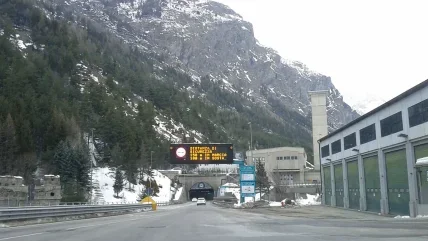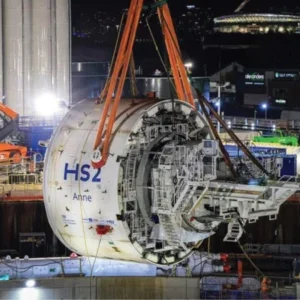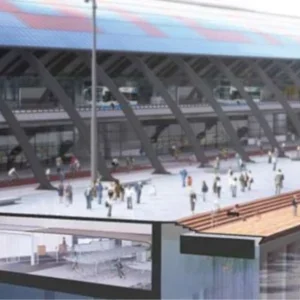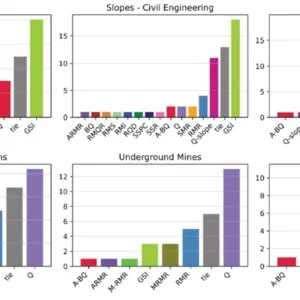
Tunnel ventilation and drainage systems provide safe, clean air for people within the tunnel, limit water intrusion, remove harmful vehicle emissions, and even play a vital role in fire safety. For these critical applications, it is essential to choose the right equipment and that can include variable speed drives (VSDs) to control fans and pumps.
Historically, tunnel ventilation systems used electric motors to power fans which ran continuously at full speed. The fan output was controlled by mechanical throttling.
Drives, meanwhile, can adjust the frequency and voltage provided to an AC motor to match the requirements of the application. This enables the control systems to automatically change the speed of the fan to meet ventilation demands, depending on the traffic within the tunnel.
In tunnel ventilation systems, this enables precise, real-time control of airflow through the system. This avoids unnecessarily high fan speeds and reduces wear on the motors, lengthening the economic lifespan of equipment.
When combined with sensors throughout the tunnel, drives in ‘comfort mode’ can automatically adjust fan speeds to maintain air quality at a specified level. In ‘fire mode’, drives run the fans at full speed – including in the opposite direction – to establish fire control zones.
Fire safety use cases will remain essential even as electric vehicles become more common and the need for exhaust ventilation is reduced.
There are also significant energy efficiency benefits to using drives. Running a motor continuously at full speed and throttling the output is an inefficient approach, similar to using the brakes to control a car’s speed while leaving the other foot on the accelerator pedal.
With a drive, any time a motor is not running at full speed, it is saving power. This is particularly significant considering that the relationship between speed and energy use is nonlinear – slowing a motor by just 20% cuts energy use by half. As a result, adding a drive to an existing fan or pump’s motor typically reduces total power consumption by 20% to 60%.
Harmonics and active front end technology.
Any non-linear electrical equipment on a network though, like VSDs, disrupts the waveform and introduces ‘electrical pollution’ in the form of harmonics. This can result in the overheating of cables, transformers, generators and motors, reducing their lifespan and wasting electricity.
To eliminate harmonics, operators can specify ultralow harmonic (ULH) drives with an active front end.
This eliminates the need to oversize other components on the network, reducing both the system’s installation footprint and the capital expenditure required.
Drives with an active front end enable active braking. This can save power through regenerative braking and has significant safety benefits. In a tunnel with a unidirectional draft, where a fan may be spinning even when unpowered, reversing a fan’s direction in an emergency depends on quickly ramping down its speed.
Many drives achieve ramp down using a brake resistor, but this creates heat, limiting its braking ability. Drives with an active front end remain cool while braking, as they recover the electricity, enabling them to ramp down and reverse a fan motor more quickly. This cooler operating temperature also means that less air conditioning is required in the electrical room, providing savings throughout the system’s life.
SPECIFYING DRIVES FOR TUNNEL APPLICATIONS
For tunnels up to around 500m in length, natural airflow is often sufficient for maintaining air quality. Longer tunnels depend on ventilation systems, typically at 690V supplied by substations at either end for road tunnels, and at 400V supplied at stations for rail tunnels.
For fire safety, however, emergency ventilation is required for road tunnels longer than 150m. In applications where the ventilation system is used exclusively for fire safety purposes, a soft starter system provides a more cost-effective solution to a drive. However, in all other applications, a VSD is the right technology.
Long cables connect drives to fans throughout the tunnel. At these lengths, voltage drop is an issue, even with copper cables. Active front end drives can increase their voltage by up to 10% to compensate for this, ensuring that fan motors have sufficient power wherever they are located within the system. This also avoids oversizing of electrical equipment, like motors, VSDs, and cables.
Drives also play a key role in tunnel excavation and construction. They are used to control the temporary ventilation systems and the dewatering systems on drilling equipment, as well as manage systems like the high-pressure water supply and conveyors. In some applications, drives even control the drill.
DRIVES IN THE ALPS, INDIA, AUSTRALIA
The Frejus road tunnel in the Alps connects France and Italy. It was constructed in 1980 and is 12km long. When its HVAC system was renovated in 2016, operators replaced 24 fans with new motors and drives. The new fans use huge 1MW motors controlled by VSDs.
During normal operations, the fans remove vehicle emissions to maintain high air quality. They are also essential to the fire safety system. In an extreme condition test, the motor-drive system withstood temperatures of 400.C for two hours without external cooling.
In Chennai, India, the metro also uses drives for air quality and fire safety. ABB ACH580 and ACS880 active front end drives compensate for voltage drop issues caused by the long cables in the tunnels, producing significant savings.
Chennai metro also relies on the drives’ ‘firefighter’s override’ feature, which enables a firefighter to run the drives at maximum speed while ignoring non-critical faults at the turn of a key. This feature buys time for the passengers to escape and firefighters to control the fire.
In Australia, the recently opened WestConnex M4-M5 link tunnel is Sydney employs ULH drives to control the 19 axial fans and reduce harmonic content by 97%. Further, VSDs are used on its 168 egress passage pressurisation fans to provide safe evacuation route in case of an incident.
DRIVING FOR BETTER, SAFER TUNNELS
VSDs enable tunnel operators – whether retrofitting an existing tunnel or fitting a new one – to maximise air quality and remain in compliance with strict safety standards. Drives also produce significant cost savings for operators, especially in terms of energy efficiency and right-sizing components. Considering these advantages, drives are a rational investment when it comes to tunnel ventilation.






